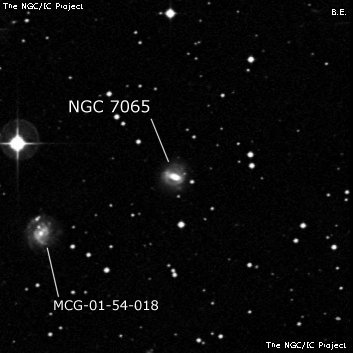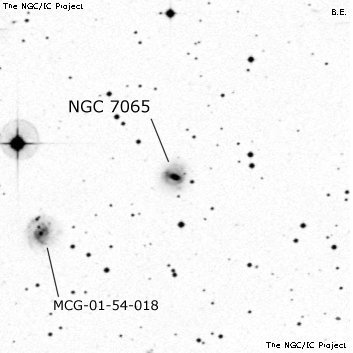NGC/IC Project Restoration Effort
(This is a very very beta version)
NGC7065


Basic Information
Location and Magnitude
Right Ascension: 21:26:42.2
Declination: -6:59:41
Constellation: AQR
Visual Magnitude: 13.4
Historic Information
Discoverer: d'Arrest
Year of discovery: 1865
Discovery aperture: 4.6
Observational
Summary description: vF, sbM, (m has 19m 33s)
Sub-type: SBab
Corwin's Notes
=====
NGC 7065. Steve Gottlieb has written to me about several objects during the
winter and spring of 2011 (see e.g. NGC 218, NGC 2128, NGC 5744); this is one.
As with a couple of the others, I can do no better than quote his note (with
his permission, of course):
[Concerning] N7065, this galaxy was discovered by Marth (m 440) on 3 Aug
1864 (credited in the NGC), and independently found [later] by both d'Arrest
on 24 Aug 1865, and Stephan on 22 Sep 1876 ([only d'A] credited by Dreyer).
Their positions for 2000 are
21 26 58 -07 02 Marth
21 26 45 -07 00.1 d'Arrest
21 26 43.3 -06 59 46 Stephan
21 26 42.9 -06 59 48 Esmiol's corrected position [from Stephan's
observations]
These suggest that while d'Arrest and Stephan observed MCG -01-54-017,
Marth's entry possibly refers to NGC 7065A = MCG -01-54-018, a larger, lower
surface brightness companion 4' SE. Both of the MCG galaxies were visible
in my 17.5" and pretty similar in terms of visibility. So, it's very
possible that both of these galaxies should have received NGC numbers. Now
the question becomes which should be tagged as the historical N7065?
Dreyer notes that Marth's RA for the NGC entry is 13 seconds of time further
east, but he nevertheless chose to assign the observations of both d'A and
Marth (he does not mention Stephan) to a single entry. In fact, as Steve has
pointed out, Marth's RA is very close to that of the MCG -01-54-018, while his
declination is just 45 arcsec south. It's a shame that Marth so rarely
mentions neighboring stars as there are several bright ones north and east of
the galaxies that he could have used as neighborhood benchmarks. d'A mentions
the nearest and brightest of these stars in both of his observations; the same
star is, in fact, Stephan's comparison star for his micrometric observations
of N7065. Is it possible that Marth thought the slightly smaller, slightly
brighter MCG -01-54-017 just a star? Given the general uncertainty of Marth's
positions (a couple of arcminutes; the other ten galaxies he found the same
night are, aside from a couple of obvious blunders, all within this general
error ellipse), it is clearly possible that he actually observed it and not
-017.
Whatever the case with Marth, it is clear that both d'A and Stephan picked up
the northwestern galaxy of the pair -- their positions and descriptions are
unambiguous. So, I've retained the northwestern galaxy -- MCG -01-54-017 --
as the main candidate for NGC 7065, but have included the southeastern as a
possible alternative.
Note that MCG -01-54-017 has a star superposed. On the Siding Spring IIIa-J
survey plate, and in the 2MASS J-band image, it is as prominent as the nuclear
region of the galaxy. Only in the 2MASS H- and K-bands does the galaxy's
nucleus show more brightly than the star. Is it possible that Marth thought
this and the galaxy's nucleus a double star?
Steve's Notes
=====
NGC 7065
17.5" (9/15/90): fairly faint, extremely small, round, bright stellar nucleus or star superimposed, just non-stellar (only core visible). Located 4.7' WSW of mag 8.8 SAO 45403 and 10.3' W of mag 7.6 SAO 45409. Forms a pair with NGC 7065A 4.2' ESE.
The companion appeared very faint, fairly small, weak concentration, very low surface brightness diffuse glow. Collinear with mag 8.8 SAO 145403 2.7' N and a mag 11 star 6.0' N. Also a mag 11 star is 3.1' E and mag 7.6 SAO 45409 is 6.3' E! Close to the mag 11 star that follows are two fainter mag 13 and 14 stars.



